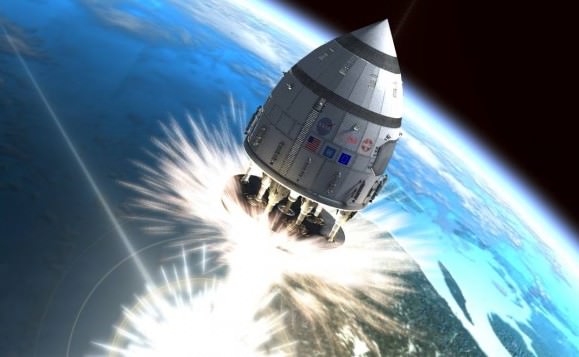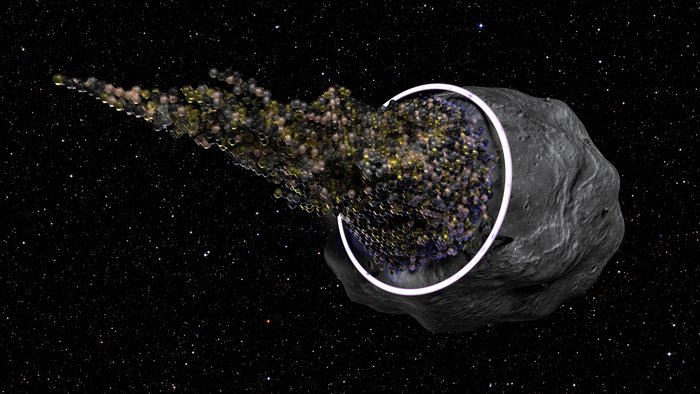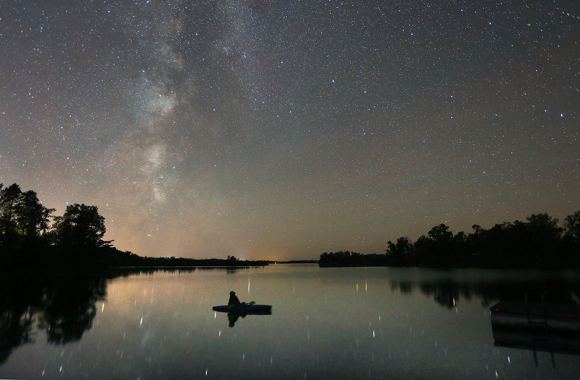There’s no two ways about it, the Universe is an extremely big place! And thanks to the limitations placed upon us by Special Relativity, traveling to even the closest star systems could take millennia. As we addressed in a previous article, the estimated travel time to the nearest star system (Alpha Centauri) could take anywhere from 19,000 to 81,000 years using conventional methods.
For this reason, many theorists have recommended that humanity should
The study, which recently appeared online, was led by Dr. Frederic Marin of the Astronomical Observatory of Strasbourg and Dr. Camille Beluffi, a particle physicist with the scientific start-up Casc4de. They were joined by Dr. Rhys Taylor of the Astronomical Institute of the Czech Academy of Science, and Dr. Loic Grau of the structural engineering firm Morphosense.
Their study is the latest in a series conducted by Dr. Marin and Dr. Beluffi that addresses the challenges of sending a multi-generational spacecraft to another star system. In a previous study, they addressed how large a generation ship’s crew would need to be in order to make it to their destination in good health.
They did this using custom-made numerical code software developed by Dr. Marin himself is known as HERITAGE. In a previous interview with Dr. Marin, he described HERITAGE as “a stochastic Monte Carlo code that accounts for all possible outcomes of space simulations by testing every randomized scenario for procreation, life and death.”
From their analysis, they determined that a minimum of 98 people would be needed to accomplish a multi-generational mission to another star system, without risks of genetic disorders and other negative effects associated with inter-marrying. For this study, the team addressed the equally important question of how to feed the crew.
Given that dried food stocks would not be a viable option, since they would deteriorate and decay during the centuries that the ship was in transit, the ship and crew would have to be equipped to grow their own food. This raises the question, how much space would be needed to produce enough crops to keep a sizeable crew fed?

When it comes to space travel, the size of the spacecraft is a major issue. As Dr. Marin explained to Universe Today via email:
“The heavier the satellite, the more expensive it is to launch it into space. Then, the larger/heavier the spaceship, the more complicated and resource-expensive will be the propulsion system. In fact, the size of the spaceship will constrain many parameters. In the case of a generation ship, the amount of food we can produce is directly related to the surface area inside the ship. This area is, in turn, related with the size of the population aboard. Size, food production and population are in fact intrinsically connected.”
To address this important question – “how big does the ship need to be?” – the team relied on an updated version of the HERITAGE software. As they state in their study, this version “accounts for age-dependent biological characteristics such as height and weight, and features related to the varying number of colonists, such as infertility, pregnancy and miscarriage rates.”
Beyond this, the team also took into account the caloric needs of the crew in order to calculate how much food would need to be produced per year. To accomplish this, the team included anthropomorphic data in their simulations to determine how many calories would be consumed based on a passenger’s age, weight, height, activity levels, and other medical data.

“Using the Harris-Benedict equation to estimate an individual’s basal metabolic rate, we evaluated how many kilo-calories must be eaten per day per person in order to maintain ideal body weight. We took care to include weight and height variations to account for a realistic population, including heavy/light corpulence and tall/small people. Once the caloric requirement was estimated, we computed how much food geoponics, hydroponics, and aeroponics farming techniques could produce per year per kilometer square.”
By comparing these numbers with conventional and modern farming techniques, they were able to predict the amount of artificial land that would have to be allocated to farming inside the vessel. They then based their overall calculations on a relatively large screw (500 people) and derived an overall figure. As Dr. Marin explained:
“We found that, for an heterogeneous crew of, e.g., 500 people living on an omnivorous, balanced diet, 0.45 km² [0.17 mi²] of artificial land would suffice in order to grow all the necessary food using a combination of aeroponics (for fruits, vegetables, starch, sugar, and oil) and conventional farming (for meat, fish, dairy, and honey).”
These values also provide some architectural constraints for the minimum size of the generation ship itself. Assuming the ship was designed to generate artificial gravity by centripetal force (i.e. a rotating cylinder) they would need to be a minimum of about 224 meters (735 feet) in radius and 320 meters (1050 feet) in length.

“Of course, other facilities besides farming are necessary – human habitation, control rooms, power generation, reaction mass, and engines, which make the spaceship at least twice larger,” Dr. Marin added. “Interestingly, even if we double the length of the spaceship, we find a structure that is still smaller than the tallest building in the world – Burj Khalifa (828 m; 2716.5 ft).”
For aficionados of interstellar space exploration and mission planners, this latest study (and others in the series) are highly significant, in that they are providing an increasingly clear picture of what the mission architecture of a generation ship would look like. Beyond merely theoretical propositions of what would be involved, these studies provide actual numbers that scientists may be able to work with someday.
And as Dr. Marin explained, it also makes such a grandiose project (which seems daunting on its face) appear that much more feasible:
“This work gives us an insight on the real possibility to create generation ships. We are already capable to build such large structures on Earth. We have now quantified with precision how large should be the surface dedicated to farming in generation ships so that the population can feed during centuries-long trips.”
According to Marin, the only remaining issue that needs to be explored is water. Any mission involving a large crew spending upwards of a few centuries in interstellar space is going to need plenty of water for drinking, irrigation, and sanitation. And it is not enough to simply rely on recycling methods to ensure a steady supply.

This, Marin indicates, will be the subject of their next study. “In deep-space (far away from planets, moons, or large asteroids), water might be very difficult to collect,” he said. “Then the resources on-board might suffer from the lack of water. We must dedicate our future investigations to solve this issue.”
As with most things pertaining to deep space exploration or the colonization of other worlds, the answer to the invariable question (“can it be done?”) is almost always the same – “How much are you willing to spend?” There is no doubt that an interstellar mission, regardless of what form it might take, would require a massive commitment in terms of time, energy, and resources.
It would also require that people be willing to risk their lives, so only adventurous people would apply. But perhaps most of all, it would need the will to see it through. Barring urgency or extreme necessity (i.e. planet Earth is doomed), it’s hard to imagine all of these factors coming together.
However, knowing exactly how much it will cost us in terms of money, resources, and time to mount such a project is a very good first step. Only then can humanity decide if they are willing to make the commitment.
Further Reading: arXiv


Clearly, I have spent way to much time chaseing greyling high up into the Elkhorns.
With artificial insemination, you could cut this right down.
It’s important to note that a star like alpha Centauri is not sitting still, it’s moving toward us fairly rapidly and at about a 48 degree angle. It will be only about 3.3 lyrs away in about 27,700 years. After that closest approach, extra energy will be required to chase it down.
We’ve been hearing about generational ships for ages now. Is this really a “thing” or is it just a theoretical exercise. I can’t think of too many things that are more morally wrong than dooming generations to spend their life in a spaceship with no other options. What makes people think the future generations will accept and behave in a way the original mission designers thought? There are just so many things that could go wrong that it seems impossible that the mission would have any chance of being successful.
Much and all as I would love to see such a mission(s), since it only took us the last 150 year to completely screw the whole planet I wouldn’t give any such ship more than a few years.